Literature Guides
The LAII's Literature Guides are lesson plans and activities that accompany young adult novels that engage in some way with Latin America, the Caribbean or Latinos in the United States. Each guide includes background on the author and book, thematic lessons and activities, and resources to support or extend the use of the book in the classroom. The lesson plans and activities encourage the teaching of literacy through the content areas and are linked to the Common Core State Standards.
We also have several guides to selected children's books that were recognized by the Américas Award.
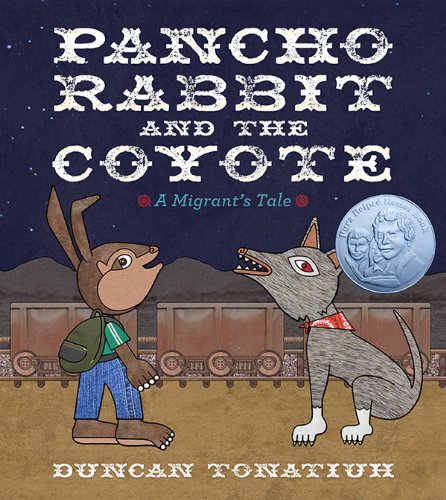
PANCHO RABBIT AND THE COYOTE: A MIGRANT'S TALE
Tonatiuh, Duncan | Harry N. Abrams, 2013 | United States/Mexico
In this allegorical picture book, a young rabbit named Pancho eagerly awaits his papa’s return. Papa Rabbit traveled north two years ago to find work in the great carrot and lettuce fields to earn money for his family. When Papa does not return, Pancho sets out to find him. He packs Papa’s favorite meal—mole, rice and beans, a heap of warm tortillas, and a jug of aguamiel—and heads north. He meets a coyote, who offers to help Pancho in exchange for some of Papa’s food. They travel together until the food is gone and the coyote decides he is still hungry . . . for Pancho! Duncan Tonatiuh brings to light the hardship and struggles faced by thousands of families who seek to make better lives for themselves and their children by illegally crossing the border.
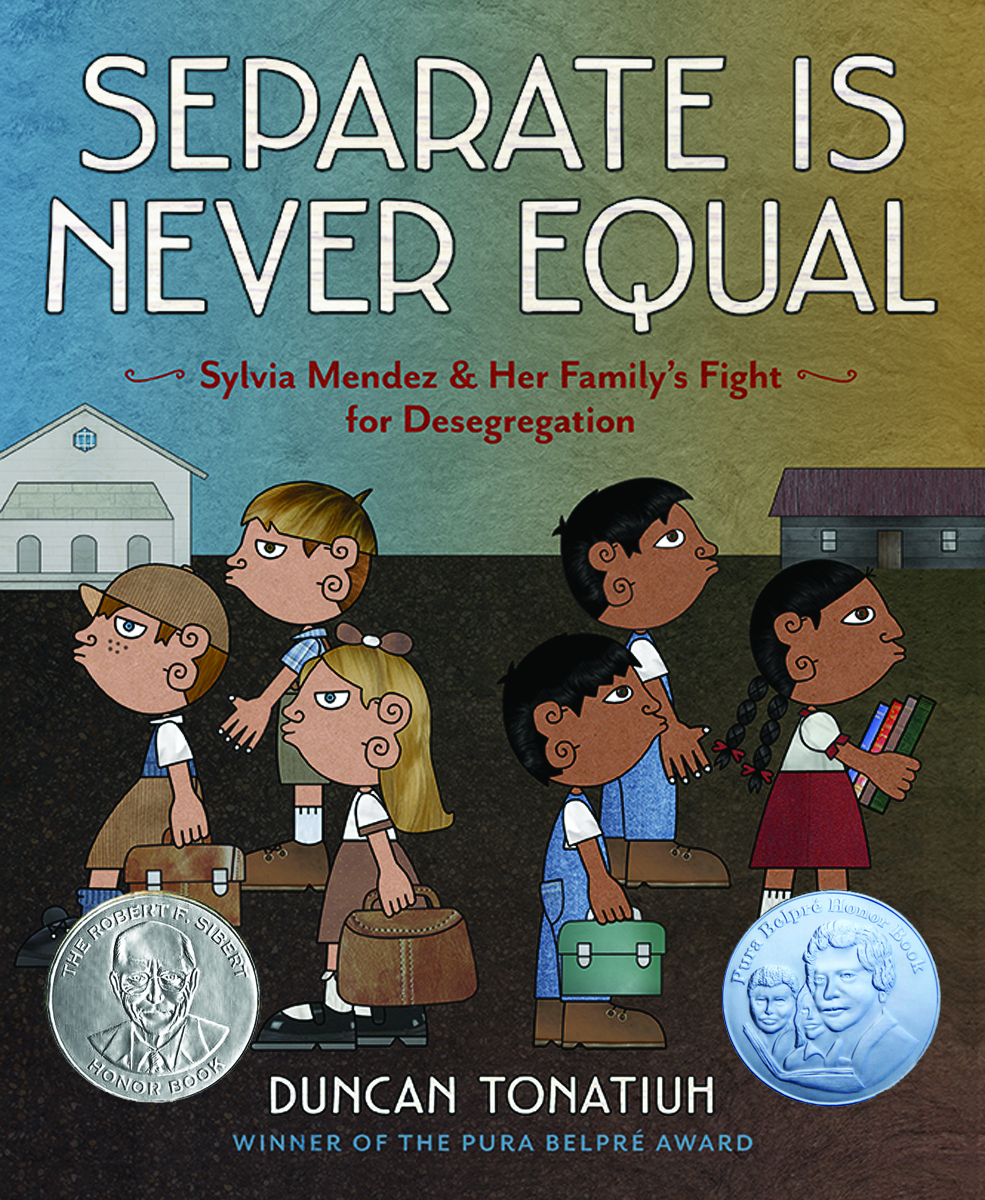
SEPARATE IS NEVER EQUAL: SYLVIA MENDEZ AND HER FAMILY'S FIGHT FOR DESEGREGATION
Tonatiuh, Duncan | Harry N. Abrams, 2014 | United States/Mexico
Almost 10 years before Brown vs. Board of Education, Sylvia Mendez and her parents helped end school segregation in California. An American citizen of Mexican and Puerto Rican heritage who spoke and wrote perfect English, Mendez was denied enrollment to a “Whites only” school. Her parents took action by organizing the Hispanic community and filing a lawsuit in federal district court. Their success eventually brought an end to the era of segregated education in California.

RETURN TO SENDER
Alvarez, Julia | Yearling, 2010 | United States/Mexico | Available in Spanish
After Tyler’s father is injured in a tractor accident, his family is forced to hire migrant Mexican workers to help save their Vermont farm from foreclosure. Tyler isn’t sure what to make of these workers. Are they undocumented? And what about the three daughters, particularly Mari, the oldest, who is proud of her Mexican heritage but also increasingly connected to her American life. Her family lives in constant fear of being discovered by the authorities and sent back to the poverty they left behind in Mexico. Can Tyler and Mari find a way to be friends despite their differences?
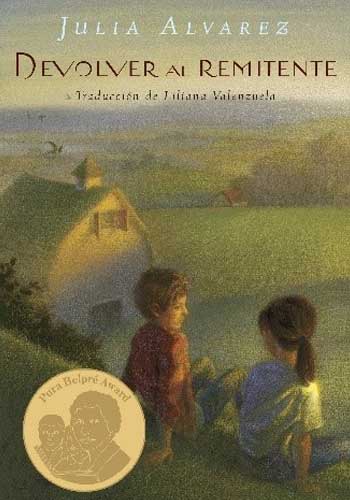
DEVOLVER AL REMITENTE
Alvarez, Julia | Yearling, 2010 | United States/Mexico | Available in English
Después de que el padre de Tyler fuese lastimado en un accidente de tractor, su familia es forzada a emplear a trabajadores migrantes mexicanos para que ayuden a salvar su rancho en Vermont. Tyler no sabe qué pensar sobre estos trabajadores. ¿Son indocumentados? Y qué se puede pensar sobre las tres hijas, especialmente Mari, la hija mayor que se siente orgullosa de su herencia hispana, pero que también se siente conectada a su vida americana. Su familia vive con un miedo constante de ser descubiertos por las autoridades y de que los regresen a México donde vivían en pobreza. ¿Podrán Tyler y Mari llegar a ser amigos a pesar de sus diferencias?

MORNING GIRL
Michael, Dorris | Scholastic, 1992 | Caribbean
This brief, lyrical novel explores the world of a sister and brother living on a lush island in the Bahamas just before the arrival of Columbus. Morning Girl and Star Boy narrate the story in alternating chapters, giving readers a view into the Taino Indian culture of which they are a part. That they must live in harmony with nature is a given; that the children recognize the power of that harmony is elegantly drawn. Says Morning Girl: "I like the aloneness of the early morning. I try to step gently on the path so that the sounds I make will blend into the rustle of the world..."

THE RED UMBRELLA
Gonzalez, Christina Diaz | Yearling-Random House, 2012 | United States/Cuba
The Red Umbrella is the moving tale of a 14-year-old girl’s journey from Cuba to America as part of Operation Pedro Pan—an organized exodus of more than 14,000 unaccompanied children, whose parents sent them away to escape Fidel Castro’s revolution. In 1961, two years after the Communist revolution, Lucía Álvarez still leads a carefree life, dreaming of parties and her first crush. But when the soldiers come to her sleepy Cuban town, everything begins to change...
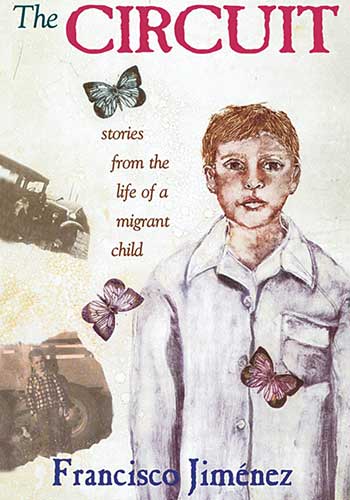
THE CIRCUIT
Jiménez, Francisco | UNM Press, 1997 | United States/Mexico | Available in Spanish
After dark in a Mexican border town, a father holds open a hole in a wire fence as his wife and two small boys crawl through. So begins life in the United States for many people every day. And so begins this collection of twelve autobiographical stories by Santa Clara University professor Francisco Jiménez, who at the age of four illegally crossed the border with his family in 1947...
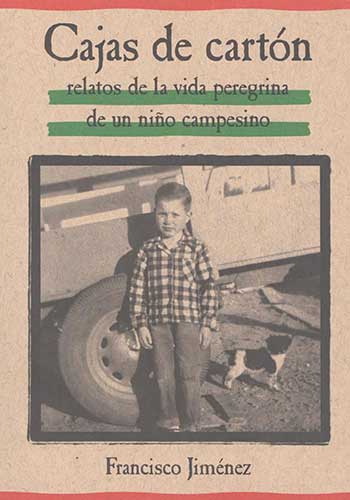
CAJAS DE CARTÓN
Jiménez, Francisco | UNM Press, 1997 | United States/Mexico | Available in English
Al anochecer en una ciudad cerca de la frontera mexicana, un padre mantiene abierto un agujero en un cerco alambrado mientras su esposa y dos niños pequeños salen por éste. Así comienza la vida en los Estados Unidos para muchas personas cada día. Y así comienza esta colección de doce escritos autobiográficos por el profesor Francisco Jiménez de la Universidad de Santa Clara, quien a la edad de cuatro años, cruzó la frontera ilegalmente con su familia en 1947...
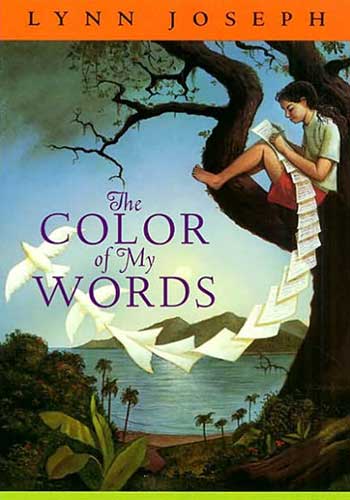
THE COLOR OF MY WORDS
Joseph, Lynn | HarperCollins, 2011 | Dominican Republic | Available in Spanish
Twelve-year-old Ana Rosa is a blossoming writer growing up in the Dominican Republic, a country where words are feared. Yet there is so much inspiration all around her- watching her brother search for a future, learning to dance and to love, and finding out what it means to be part of a community- that Ana Rosa must write it all down. As she struggles to find her own voice and a way to make it heard, Ana Rosa realizes the power of her words to transform the world around her- and to transcend the most unthinkable of tragedies. Download Educator's Guide to The Color Of My Words

EL COLOR DE MIS PALABRAS
Joseph, Lynn | HarperCollins, 2011 | Dominican Republic | Available in English
Ana Rosa es una escritora joven de doce años y vive en la República Dominicana, un país donde las palabras son temidas. Sin embargo, está rodeada por mucha inspiración—ver a su hermano buscar un futuro, aprender a bailar y amar, y buscar el significado de ser parte de una comunidad—por lo que escribirá mucho. Mientras lucha para encontrar su propia voz y la manera de proyectarla, Ana Rosa pone en práctica el poder de sus palabras para transformar el mundo a su alrededor y para superar las tragedias más inconcebibles.

SUMMER OF THE MARIPOSAS
McCall, Guadalupe Garcia | Lee & Low Books, 2012 | United States/Mexico | Available in Spanish
When Odilia and her four sisters find a dead body in the swimming hole, they embark on a hero’s journey to return the dead man to his family in Mexico. But returning home to Texas turns into an odyssey that would rival Homer’s original tale. Summer of the Mariposas is not just a magical Mexican American retelling of The Odyssey, it is a celebration of sisterhood and maternal love
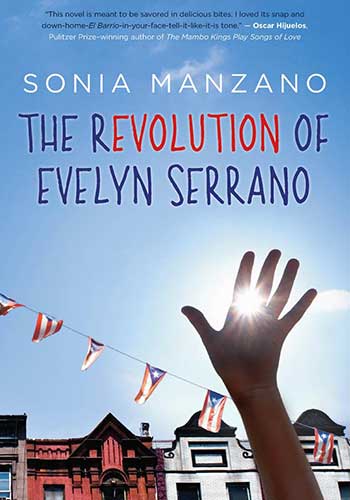
THE REVOLUTION OF EVELYN SERRANO
Manzano, Sonia | Yearling, 2010 | United States/Puerto Rico
There are two secrets Evelyn Serrano is keeping from her Mami and stepfather. Her true feelings about growing up in her Spanish Harlem neighborhood, and her attitude about Abuela, her sassy grandmother who’s come from Puerto Rico to live with them. Then, like an urgent ticking clock, events erupt that change everything. The Young Lords, a Puerto Rican activist group, dump garbage in the street and set it on fire, igniting a powerful protest. When Abuela steps in to take charge, Evelyn is thrust into the action. Tempers flare, loyalties are tested. Through it all, Evelyn learns important truths about her Latino heritage and the history makers who shaped a nation. Infused with actual news accounts from the time period, Sonia Manzano has crafted a gripping work of fiction based on her own life growing up during a fiery, unforgettable time in America, when young Latinos took control of their destinies.
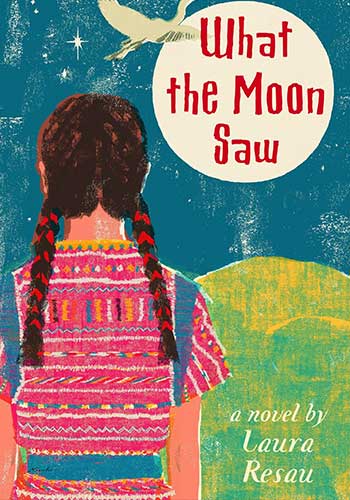
WHAT THE MOON SAW
Resau, Laura | Yearling, 2008 | United States/Mexico
Clara Luna’s name means “clear moon” in Spanish. But lately, her head has felt anything but clear. One day a letter comes from Mexico, written in Spanish: Dear Clara, We invite you to our house for the summer. We will wait for you on the day of the full moon, in June, at the Oaxaca airport. Love, your grandparents. Fourteen-year-old Clara has never met her father’s parents. She knows he snuck over the border from Mexico as a teenager, but beyond that, she knows almost nothing about his childhood. When she agrees to go, she’s stunned by her grandparents’ life: they live in simple shacks in the mountains of southern Mexico, where most people speak not only Spanish, but an indigenous language, Mixteco...
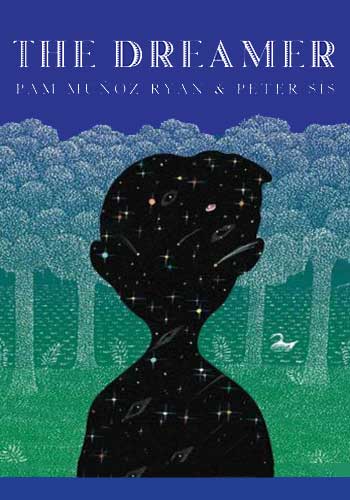
THE DREAMER
Ryan, Pam Muñoz | Scholastic, 2010 | Chile | Available in Spanish
From the time he is a young boy, Neftalí hears the call of a mysterious voice. Even when the neighborhood children taunt him, and when his harsh, authoritarian father ridicules him, and when he doubts himself, Neftalí knows he cannot ignore the call. Under the canopy of the lush rain forest, into the fearsome sea, and through the persistent Chilean rain, he listens and he follows. . . Combining elements of magical realism with biography, poetry, literary fiction, and sensorial, transporting illustrations, Pam Muñoz Ryan and Peter Sís take readers on a rare journey of the heart and imagination
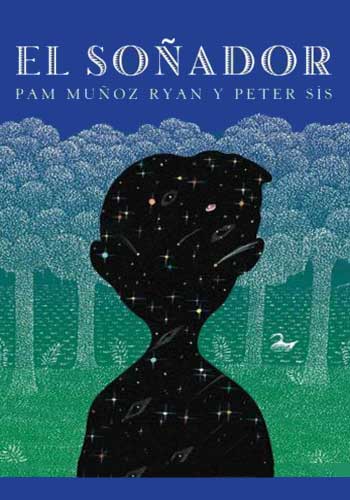
EL SOÑADOR
Ryan, Pam Muñoz | Scholastic, 2010 | Chile | Available in English
Desde el momento en que él es un muchacho joven, Neftalí escucha la llamada de una voz misteriosa. Incluso cuando los niños del barrio se burlan de él, y cuando su duro, autoritario padre le ridiculiza, y cuando el mismo se duda, Neftalí sabe que no puede ignorar la llamada. Bajo el dosel de la selva exuberante, en el mar temible, y a través de la lluvia persistente de Chile, el escucha y sigue. Combinando elementos del realismo mágico con la biografía, la poesía, la ficción literaria, y ilustraciones sensoriales, Pam Muñoz Ryan y Peter Sís llevan los lectores en un viaje raro del corazón y la imaginación.
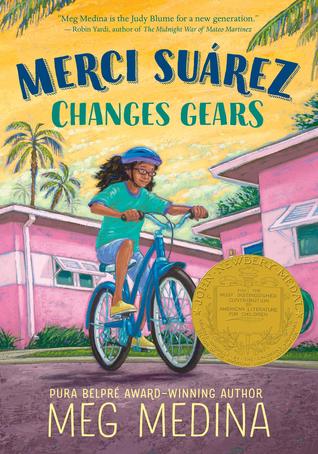
Merci Suárez Changes Gears
Meg Medina | Candlewick, 2018 |
Merci Suarez knew that sixth grade would be different, but she had no idea just how different. For starters, Merci has never been like the other kids at her private school in Florida, because she and her older brother, Roli, are scholarship students. They don’t have a big house or a fancy boat, and they have to do extra community service to make up for their free tuition. So when bossy Edna Santos sets her sights on the new boy who happens to be Merci’s school-assigned Sunshine Buddy, Merci becomes the target of Edna’s jealousy. Things aren't going well at home, either: Merci’s grandfather and most trusted ally, Lolo, has been acting strangely lately — forgetting important things, falling from his bike, and getting angry over nothing. No one in her family will tell Merci what's going on, so she’s left to her own worries, while also feeling all on her own at school. In a coming-of-age tale full of humor and wisdom, award-winning author Meg Medina gets to the heart of the confusion and constant change that defines middle school — and the steadfast connection that defines family.
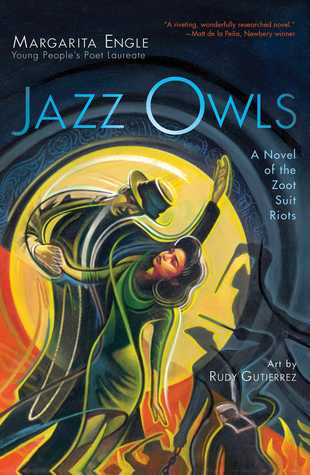
Jazz Owls
Margarita Engle | Atheneum Books for Young Readers, 2018 |
Thousands of young Navy sailors are pouring into Los Angeles on their way to the front lines of World War II. They are teenagers, scared, longing to feel alive before they have to face the horrors of battle. Hot jazz music spiced with cool salsa rhythms calls them to dance with the local Mexican American girls, who jitterbug all night before working all day in the canneries. Proud to do their part for the war effort, these Jazz Owl girls are happy to dance with the sailors—until the blazing summer night when racial violence leads to murder. Suddenly the young white sailors are attacking these girls’ brothers and boyfriends. The cool, loose zoot suits they wear are supposedly the reason for the violence—when in reality these boys are viciously beaten and arrested simply because of the color of their skin.

ESTRELLA'S QUINCEAÑERA
Alegría, Malín | Simon & Schuster, 2007 | United States/Mexico
For as long as Estrella Alvarez can remember, her mother has been planning to throw her an elaborate quinceañera for her fifteenth birthday — complete with a mariachi band, cheesy decorations, and a hideous dress. Just thinking about her quince makes Estrella cringe. But her mother insists that it’s tradition. Estrella has other things on her mind, anyway — like dating Speedy. Does it matter that her new friends — and her parents — would never approve of a guy from el barrio? Estrella’s almost fifteen and wants to start making her own decisions. But is she ready to find out who she is — and who she really wants to be?

RETURN TO SENDER
Alvarez, Julia | Yearling, 2010 | United States/Mexico | Available in Spanish
After Tyler’s father is injured in a tractor accident, his family is forced to hire migrant Mexican workers to help save their Vermont farm from foreclosure. Tyler isn’t sure what to make of these workers. Are they undocumented? And what about the three daughters, particularly Mari, the oldest, who is proud of her Mexican heritage but also increasingly connected to her American life. Her family lives in constant fear of being discovered by the authorities and sent back to the poverty they left behind in Mexico. Can Tyler and Mari find a way to be friends despite their differences?

DEVOLVER AL REMITENTE
Alvarez, Julia | Yearling, 2010 | United States/Mexico | Available in English
Después de que el padre de Tyler fuese lastimado en un accidente de tractor, su familia es forzada a emplear a trabajadores migrantes mexicanos para que ayuden a salvar su rancho en Vermont. Tyler no sabe qué pensar sobre estos trabajadores. ¿Son indocumentados? Y qué se puede pensar sobre las tres hijas, especialmente Mari, la hija mayor que se siente orgullosa de su herencia hispana, pero que también se siente conectada a su vida americana. Su familia vive con un miedo constante de ser descubiertos por las autoridades y de que los regresen a México donde vivían en pobreza. ¿Podrán Tyler y Mari llegar a ser amigos a pesar de sus diferencias?
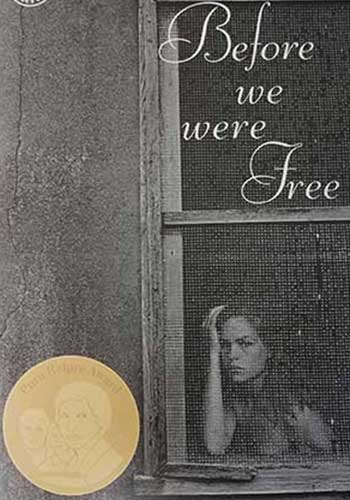
BEFORE WE WERE FREE
Alvarez, Julia | Laurel Leaf, 2004 | Dominican Republic/ | Available in Spanish
Anita de la Torre never questioned her freedom living in the Dominican Republic. But by her 12th birthday in 1960, most of her relatives have emigrated to the United States, her Tío Toni has disappeared without a trace, and the government’s secret police terrorize her remaining family because of their suspected opposition of el Trujillo’s dictatorship. Using the strength and courage of her family, Anita must overcome her fears and fly to freedom, leaving all that she once knew behind. From renowned author Julia Alvarez comes an unforgettable story about adolescence, perseverance, and one girl’s struggle to be free.
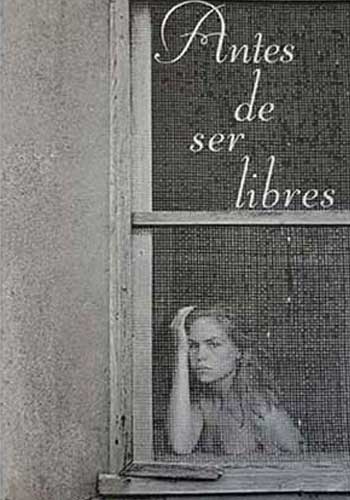
ANTES DE SER LIBRES
Alvarez, Julia | Laurel Leaf, 2004 | Dominican Republic/ | Available in English
Anita de la Torre nunca dudó de su libertad mientras vivía en la República Dominicana. Pero para su doceavo cumpleaños en el año 1960, muchos de sus familiares han emigrado a los Estados Unidos, su tío Toni ha desaparecido, y la policía secreta aterroriza su familia por su supuesta oposición al dictador de su país. Mientras sus años en la secundaria deberían enfocarse en la escuela, los niños, sus hermanas, y la pubertad, Anita también brega con palabras de código, escapes peligrosos, y complots de asesinatos. Inspirado por la perseverancia y fuerza inmedible de su familia, Anita lucha por superar sus miedos y hacer un escape dramático hacia la libertad, dejando atrás todo lo que antes conocía.

CAMINAR
Brown, Skila | Candlewick, 2014 | Guatemala/ | Available in Spanish
Carlos knows that when the soldiers arrive with warnings about the Communist rebels, it is time to be a man and defend the village, keep everyone safe. But Mama tells him not yet — he’s still her quiet moonfaced boy. The soldiers laugh at the villagers, and before they move on, a neighbor is found dangling from a tree, a sign on his neck: Communist. Mama tells Carlos to run and hide, then try to find her. . . . Numb and alone, he must join a band of guerillas as they trek to the top of the mountain where Carlos’s abuela lives. Will he be in time, and brave enough, to warn them about the soldiers? What will he do then? A novel in verse inspired by actual events during Guatemala’s civil war, Caminar is the moving story of a boy who loses nearly everything before discovering who he really is.
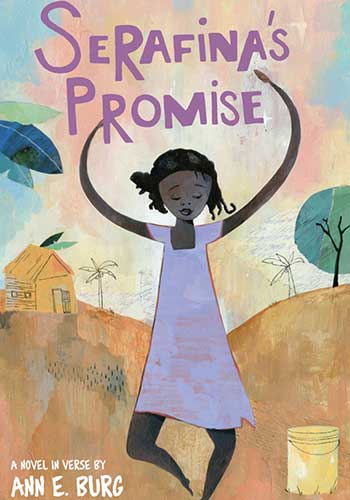
SERAFINA'S PROMISE
Burg, Ann | Scholastic, 2013 | Haiti/
Serafina has // a secret dream. She wants to go to school // and become a doctor // with her best friend, Julie Marie. But in their rural village // outside Port-au-Prince, Haiti, // many obstacles // stand in Serafina’s way– // little money, // never-ending chores, // and Manman’s worries. More powerful even // than all of these // are the heavy rains // and the shaking earth // that test Serafina’s resolve // in ways she never dreamed. At once heartbreaking and hopeful, // this exquisitely crafted story // will leave a lasting impression // on your heart.

LEAVING GLORYTOWN: ONE BOY'S STRUGGLE UNDER CASTRO
Calcines, Eduardo F. | Farrar, Strauss & Giroux, 2009 | Cuba/
Eduardo F. Calcines was a child of Fidel Castro’s Cuba; he was just three years old when Castro came to power in January 1959. After that, everything changed for his family and his country. When he was ten, his family applied for an exit visa to emigrate to America and he was ridiculed by his schoolmates and even his teachers for being a traitor to his country. But even worse, his father was sent to an agricultural reform camp to do hard labor as punishment for daring to want to leave Cuba. During the years to come, as he grew up in Glorytown, a neighborhood in the city of Cienfuegos, Eduardo hoped with all his might that their exit visa would be granted before he turned fifteen, the age at which he would be drafted into the army. In this absorbing memoir, by turns humorous and heartbreaking, Eduardo Calcines recounts his boyhood and chronicles the conditions that led him to wish above all else to leave behind his beloved extended family and his home for a chance at a better future.

COLIBRI
Cameron, Ann | Laurel Leaf, 2005 | Guatemala/ | Available in Spanish
She was little and quick and pretty. Her mother nicknamed her Colibrí, Spanish for “Hummingbird.” At age four she was kidnapped, torn from her parents on a crowded bus in Guatemala City. Since then she’s travelled with "Uncle," the ex-soldier and wandering beggar who has renamed her Rosa. Uncle has always told Rosa that he searched for her parents but had no success. There’s almost no chance Rosa will ever find them, but Rosa still remembers and longs for them. When she was young, Uncle consulted fortune-tellers who told him that Rosa would bring him luck – a treasure big enough to last him all his life. So he’s kept her with him. Together, they have travelled from town to town in the highlands of Guatemala, scraping out a living, hoping to find the treasure. Eight years have passed, and Rosa has turned twelve. No treasure has been found, and Uncle has almost given up hope. When he turns angry and desperate, danger threatens Rosa from all side, but especially from Uncle himself.

COLIBRI
Cameron, Ann | Laurel Leaf, 2005 | Guatemala/ | Available in English
Su madre la llamó Colibrí porque era una niña chiquita y hermosa. A los cuatro años fue raptada en la Ciudad de Guatemala mientras viajaba con sus padres en un autobús. Desde entonces, ha viajado con un ex soldado mendigo y andariego, su "tío", que la llama Rosa. Él siempre le ha dicho que buscó a sus padres, pero lo cierto es que cuando Rosa era joven, una adivina le dijo que la niña le ayudaría a encontrar un tesoro muy grande que le duraría toda la vida y es la única razón por la que la mantiene a su lado. Pero Rosa ya tiene 12 años y no hay señal del tesoro y Tío se está impacientando.
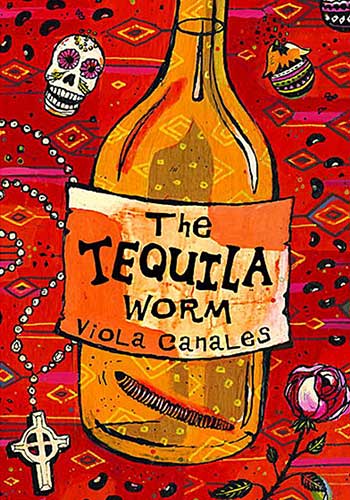
THE TEQUILA WORM
Canales, Viola | Random House, 2007 | United States/
Sofia comes from a family of storytellers. Here are her tales of growing up in the barrio, full of the magic and mystery of family traditions: making Easter cascarones, celebrating el Día de los Muertos, preparing for quinceañera, rejoicing in the Christmas nacimiento, and curing homesickness by eating the tequila worm. When Sofia is singled out to receive a scholarship to an elite boarding school, she longs to explore life beyond the barrio, even though it means leaving her family to navigate a strange world of rich, privileged kids. It’s a different mundo, but one where Sofia’s traditions take on new meaning and illuminate her path.
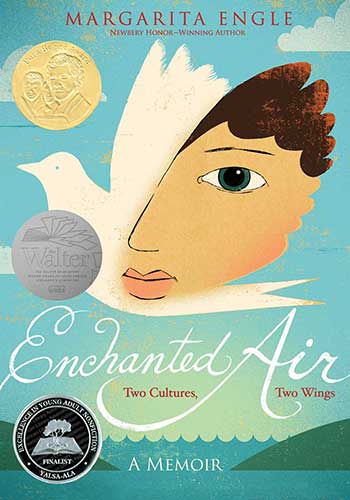
ENCHANTED AIR: TWO CULTURES, TWO WINGS
Engle, Margarita | Atheneum, 2015 | Cuba/United States | Available in Spanish
In this poetic memoir, which won the Pura Belpré Author Award, acclaimed author Margarita Engle tells of growing up as a child of two cultures during the Cold War. Margarita is a girl from two worlds. Her heart lies in Cuba, her mother’s tropical island country, a place so lush with vibrant life that it seems like a fairy tale kingdom. But most of the time she lives in Los Angeles, lonely in the noisy city and dreaming of the summers when she can take a plane through the enchanted air to her beloved island. Words and images are her constant companions, friendly and comforting when the children at school are not.

HURRICANE DANCERS: THE FIRST CARIBBEAN PIRATE SHIPWRECK
Engle, Margarita | Henry Holt & Co., 2011 | Caribbean/
Quebrado has been traded from pirate ship to ship in the Caribbean Sea for as long as he can remember. The sailors he toils under call him el quebrado—half islander, half outsider, a broken one. Now the pirate captain Bernardino de Talavera uses Quebrado as a translator to help navigate the worlds and words between his mother’s Taíno Indian language and his father’s Spanish. But when a hurricane sinks the ship and most of its crew, it is Quebrado who escapes to safety. He learns how to live on land again, among people who treat him well. And it is he who must decide the fate of his former captors.
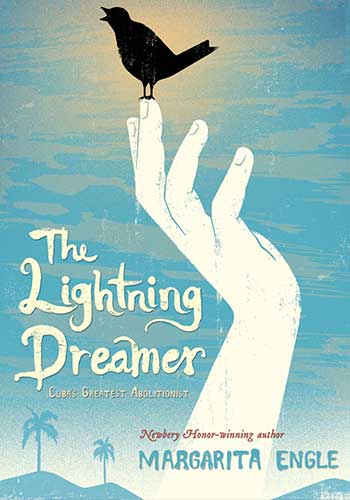
THE LIGHTNING DREAMER: CUBA'S GREAT ABOLITIONIST
Engle, Margarita | HMH Books, 2013 | Cuba/
“I find it so easy to forget / that I’m just a girl who is expected / to live / without thoughts.” Opposing slavery in Cuba in the nineteenth century was dangerous. The most daring abolitionists were poets who veiled their work in metaphor. Of these, the boldest was Gertrudis Gómez de Avellaneda, nicknamed Tula. In passionate, accessible verses of her own, Engle evokes the voice of this book-loving feminist and abolitionist who bravely resisted an arranged marriage at the age of fourteen, and was ultimately courageous enough to fight against injustice. Historical notes, excerpts, and source notes round out this exceptional tribute.
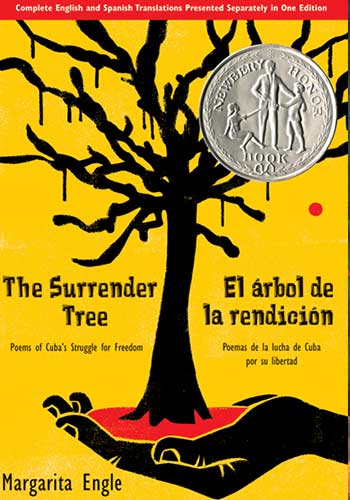
THE SURRENDER TREE
Engle, Margarita | Henry Holt & Co, 2010 | Cuba/ | Available in Spanish
It is 1896. Cuba has fought three wars for independence and still is not free. People have been rounded up in concentration camps with too little food and too much illness. Rosa is a nurse, but with a price on her head for helping the rebels, she dares not go to the camps. Instead, she turns hidden caves into hospitals for those who know how to find her. Black, white, Cuban, Spanish—Rosa does her best for everyone. Yet who can heal a country so torn apart by war?

EL ÁRBOL DE LA RENDICIÓN
Engle, Margarita | Henry Holt & Co, 2010 | Cuba/ | Available in English
Es el año 1896. Cuba ha enfrentado en tres guerras por la independencia y todavía no es libre. Las personas han sido detenidos en campos de concentración, con muy poca comida y demasiada enfermedad. Rosa es una enfermera, pero con un precio sobre su cabeza para ayudar a los rebeldes, no se atreve a ir a los campamentos. En cambio, ella se vuelve cuevas ocultas en los hospitales para los que saben cómo encontrarla. Negro, blanco, cubano, español-Rosa hace lo mejor para todos. Pero, ¿quién puede sanar un país tan desgarrado por la guerra?

LA LÍNEA
Jaramillo, Ann | Square Fish, 2006 | Mexico/
Miguel’s life is just beginning. Or so he thinks. Fifteen-year-old Miguel leaves his rancho deep in Mexico to migrate to California across la línea, the border, in a debut novel of life-changing, cliff-hanging moments. But Miguel’s carefully laid plans change suddenly when his younger sister Elena stows away and follows him. Together, Miguel and Elena endure hardships and danger on their journey of desperation and desire, loyalty and betrayal. An epilogue, set ten years after the events of the story, shows that you can’t always count on dreams–even the ones that come true.

THE CIRCUIT
Jiménez, Francisco | University of New Mexico Press, 1997 | Mexico/United States | Available in Spanish
After dark in a Mexican border town, a father holds open a hole in a wire fence as his wife and two small boys crawl through. So begins life in the United States for many people every day. And so begins this collection of twelve autobiographical stories by Santa Clara University professor Francisco Jiménez, who at the age of four illegally crossed the border with his family in 1947...

CAJAS DE CARTÓN
Jiménez, Francisco | University of New Mexico Press, 1997 | 1997/United States | Available in English
Al anochecer en una ciudad cerca de la frontera mexicana, un padre mantiene abierto un agujero en un cerco alambrado mientras su esposa y dos niños pequeños salen por éste. Así comienza la vida en los Estados Unidos para muchas personas cada día. Y así comienza esta colección de doce escritos autobiográficos por el profesor Francisco Jiménez de la Universidad de Santa Clara, quien a la edad de cuatro años, cruzó la frontera ilegalmente con su familia en 1947...
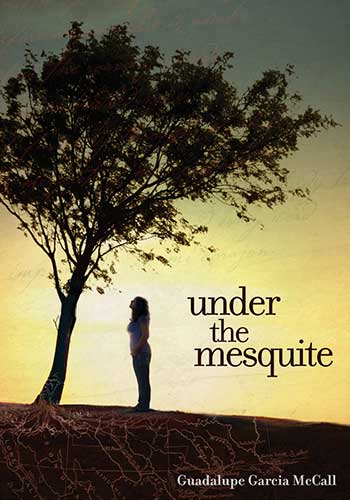
UNDER THE MESQUITE
McCall, Guadalupe Garcia | Lee & Low, 2011 | United States/
Lupita, a budding actor and poet in a close-knit Mexican American immigrant family, comes of age as she struggles with adult responsibilities during her mother’s battle with cancer in this young adult novel in verse. When Lupita learns Mami has cancer, she is terrified by the possibility of losing her mother, the anchor of her close-knit family. Suddenly, being a high school student, starring in a play, and dealing with friends who don’t always understand, become less important than doing whatever she can to save Mami’s life. While her father cares for Mami at an out-of-town clinic, Lupita takes charge of her seven younger siblings. As Lupita struggles to keep the family afloat, she takes refuge in the shade of a mesquite tree, where she escapes the chaos at home to write. Forced to face her limitations in the midst of overwhelming changes and losses, Lupita rediscovers her voice and finds healing in the power of words. Told with honest emotion in evocative free verse, Lupita’s journey toward hope is captured in moments that are alternately warm and poignant. Under the Mesquite is an empowering story about testing family bonds and the strength of a young woman navigating pain and hardship with surprising resilience.

THE REVOLUTION OF EVELYN SERRANO
Manzano, Sonia | Scholastic, 2012 | United States/Puerto Rico
There are two secrets Evelyn Serrano is keeping from her Mami and stepfather. Her true feelings about growing up in her Spanish Harlem neighborhood, and her attitude about Abuela, her sassy grandmother who’s come from Puerto Rico to live with them. Then, like an urgent ticking clock, events erupt that change everything. The Young Lords, a Puerto Rican activist group, dump garbage in the street and set it on fire, igniting a powerful protest. When Abuela steps in to take charge, Evelyn is thrust into the action. Tempers flare, loyalties are tested. Through it all, Evelyn learns important truths about her Latino heritage and the history makers who shaped a nation. Infused with actual news accounts from the time period, Sonia Manzano has crafted a gripping work of fiction based on her own life growing up during a fiery, unforgettable time in America, when young Latinos took control of their destinies.
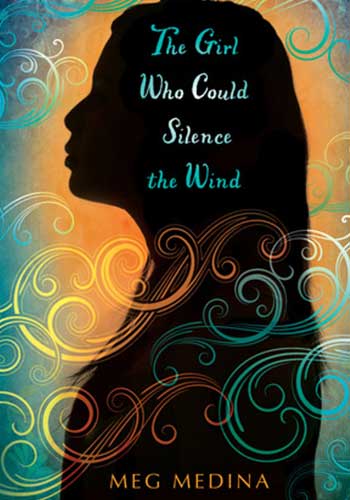
THE GIRL WHO COULD SILENCE THE WIND
Medina, Meg | Candlewick, 2013 | United States/
Sixteen-year-old Sonia Ocampo was born on the night of the worst storm Tres Montes had ever seen. And when the winds mercifully stopped, an unshakable belief in the girl’s protective powers began. All her life, Sonia has been asked to pray for sick mothers or missing sons, as worried parents and friends press silver milagros in her hands. Sonia knows she has no special powers, but how can she disappoint those who look to her for solace? Still, her conscience is heavy, so when she gets a chance to travel to the city and work in the home of a wealthy woman, she seizes it. At first, Sonia feels freedom in being treated like all the other girls. But when news arrives that her beloved brother has disappeared while looking for work, she learns to her sorrow that she can never truly leave the past or her family behind.

YAQUI DELGADO WANTS TO KICK YOUR ASS
Medina, Meg | Candlewick, 2013 | United States/
One morning before school, some girl tells Piddy Sanchez that Yaqui Delgado hates her and wants to kick her ass. Piddy doesn’t even know who Yaqui is, never mind what she’s done to piss her off. Word is that Yaqui thinks Piddy is stuck-up, shakes her stuff when she walks, and isn’t Latin enough with her white skin, good grades, and no accent. And Yaqui isn’t kidding around, so Piddy better watch her back. At first Piddy is more concerned with trying to find out more about the father she’s never met and how to balance honors courses with her weekend job at the neighborhood hair salon. But as the harassment escalates, avoiding Yaqui and her gang starts to take over Piddy’s life. Is there any way for Piddy to survive without closing herself off or running away? In an all-too-realistic novel, Meg Medina portrays a sympathetic heroine who is forced to decide who she really is.

Shadowshaper
Older, Daniel José | Levine, 2015 | Caribbean/United States
Paint a mural. Start a battle. Change the world. Sierra Santiago planned an easy summer of making art and hanging out with her friends. But then a corpse crashes the first party of the season. Her stroke-ridden grandfather starts apologizing over and over. And when the murals in her neighborhood begin to weep real tears… Well, something more sinister than the usual Brooklyn ruckus is going on. With the help of a fellow artist named Robbie, Sierra discovers shadowshaping, a thrilling magic that infuses ancestral spirits into paintings, music, and stories. But someone is killing the shadowshapers one by one — and the killer believes Sierra is hiding their greatest secret. Now she must unravel her family’s past, take down the killer in the present, and save the future of shadowshaping for generations to come. Full of a joyful, defiant spirit and writing as luscious as a Brooklyn summer night, Shadowshaper introduces a heroine and magic unlike anything else in fantasy fiction, and marks the YA debut of a bold new voice.
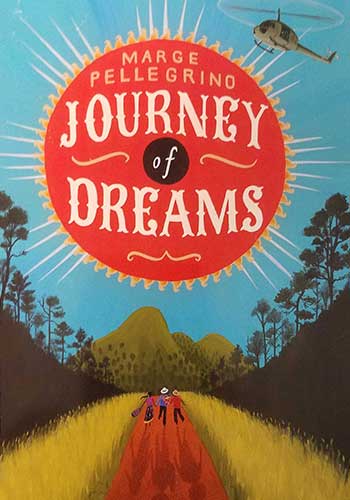
JOURNEY OF DREAMS
Pellegrino, Marge | Frances Lincoln, 2009 | Guatemala/
For the peaceful highlanders of Guatemala, life has become a nightmare. Helicopters slash like machetes through the once-quiet air. Soldiers patrol the streets, hunting down suspected guerillas. Villagers mysteriously disappear and children are recruited as soldiers. Tomasa’s family is growing increasingly desperate, especially after Mama goes into hiding with Tomasa’s oldest brother. Finally, after their house is razed to the ground and the villagers massacred, Tomasa, Manuelito, and baby Maria set off with Papa on a perilous journey to find Mama and Carlos, only to discover that where one journey ends, another begins. This gripping novel tells the story of how Tomasa’s family survives the Guatemalan army’s brutal regime and how, in the midst of tragedy, their love and loyalty — and Papa’s storytelling — keeps them going on their harrowing journey as refugees to the United States. Mirrored in the tapestries of Tomasa’s dreams, the dramatic events of the Guatemalan army’s “scorched earth” campaign of the 1980s are tempered with hope and the generosity of the human spirit.

THE QUEEN OF WATER
Resau, Laura | Delacorte, 2011 | Ecuador/
Born in an Andean village in Ecuador, Virginia lives with her family in a small, earthen-walled dwelling. In her village of indígenas, it’s not uncommon to work in the fields all day, even as a child, or to be called a longa tonta -stupid Indian -by the ruling class of mestizos, or Spanish descendants. On the day Virginia is taken from her village to be an unpaid servant to a mestizo couple, she has no idea what the next decade will hold for her. In this poignant novel based on a true story, acclaimed author Laura Resau has collaborated with María Virginia Farinango to recount an indigenous girl’s unforgettable journey to self-discovery that will speak to anyone who has ever struggled to find his or her place in the world. Virginia’s story will make you laugh and cry, and ultimately, fill you with hope.

THE DREAMER
Ryan, Pam Muñoz | Scholastic, 2010 | Chile/ | Available in Spanish
From the time he is a young boy, Neftalí hears the call of a mysterious voice. Even when the neighborhood children taunt him, and when his harsh, authoritarian father ridicules him, and when he doubts himself, Neftalí knows he cannot ignore the call. Under the canopy of the lush rain forest, into the fearsome sea, and through the persistent Chilean rain, he listens and he follows. . . Combining elements of magical realism with biography, poetry, literary fiction, and sensorial, transporting illustrations, Pam Muñoz Ryan and Peter Sís take readers on a rare journey of the heart and imagination

EL SOÑADOR
Ryan, Pam Muñoz | Scholastic, 2010 | Chile/ | Available in English
Desde el momento en que él es un muchacho joven, Neftalí escucha la llamada de una voz misteriosa. Incluso cuando los niños del barrio se burlan de él, y cuando su duro, autoritario padre le ridiculiza, y cuando el mismo se duda, Neftalí sabe que no puede ignorar la llamada. Bajo el dosel de la selva exuberante, en el mar temible, y a través de la lluvia persistente de Chile, el escucha y sigue. Combinando elementos del realismo mágico con la biografía, la poesía, la ficción literaria, y ilustraciones sensoriales, Pam Muñoz Ryan y Peter Sís llevan los lectores en un viaje raro del corazón y la imaginación.
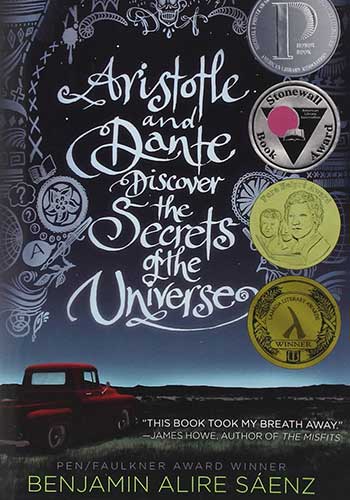
ARISTOTLE AND DANTE DISCOVER THE SECRETS OF THE UNIVERSE
Sáenz, Benjamin Alire | Simon & Schuster, 2012 | United States/
Aristotle is an angry teen with a brother in prison. Dante is a know-it-all who has an unusual way of looking at the world. When the two meet at the swimming pool, they seem to have nothing in common. But as the loners start spending time together, they discover that they share a special friendship—the kind that changes lives and lasts a lifetime. And it is through this friendship that Ari and Dante will learn the most important truths about themselves and the kind of people they want to be.
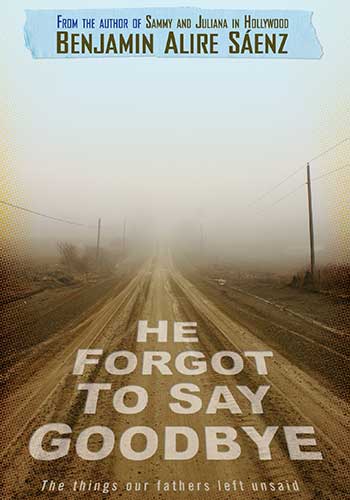
HE FORGOT TO SAY GOODBYE
Sáenz, Benjamin Alire | Simon & Schuster, 2012 | United States/
Ramiro Lopez and Jake Upthegrove don’t appear to have much in common. Ram lives in the Mexican-American working-class barrio of El Paso called “Dizzy Land.” His brother is sinking into a world of drugs, wreaking havoc in their household. Jake is a rich West Side white boy who has developed a problem managing his anger. An only child, he is a misfit in his mother’s shallow and materialistic world. But Ram and Jake do have one thing in common: They are lost boys who have never met their fathers. This sad fact has left both of them undeniably scarred and obsessed with the men who abandoned them. As Jake and Ram overcome their suspicions of each other, they begin to move away from their loner existences and realize that they are capable of reaching out beyond their wounds and the neighborhoods that they grew up in. Their friendship becomes a healing in a world of hurt.

Because of the Sun
Jenny Torres Sánchez | Delacorte Press, 2017 |
Dani learned to tolerate her existence in suburban Florida with her brash and seemingly unloving mother by embracing the philosophy Why care? It will only hurt. So when her mother is killed in a sudden and violent manner, Dani goes into an even deeper protection mode, total numbness. It's the only way she can go on. But when Dani chooses The Stranger by Albert Camus as summer reading for school, it feels like fate. The main character's alienation after his mother's death mirrors her own. Dani's life is thrown into further turmoil when she is sent to New Mexico to live with an aunt she never knew she had. The awkwardness between them is palpable. To escape, Dani takes long walks in the merciless heat. One day, she meets Paulo, who understands how much Dani is hurting. Although she is hesitant at first, a mutual trust and affection develops between them. And as she and her aunt begin to connect, Dani learns about her mother's past. Forgiving isn't easy, but maybe it's the only way to move forward.

ESTRELLA'S QUINCEAÑERA
Alegría, Malín | Simon & Schuster, 2007 | United States
For as long as Estrella Alvarez can remember, her mother has been planning to throw her an elaborate quinceañera for her fifteenth birthday — complete with a mariachi band, cheesy decorations, and a hideous dress. Just thinking about her quince makes Estrella cringe. But her mother insists that it’s tradition. Estrella has other things on her mind, anyway — like dating Speedy. Does it matter that her new friends — and her parents — would never approve of a guy from el barrio? Estrella’s almost fifteen and wants to start making her own decisions. But is she ready to find out who she is — and who she really wants to be?

BEFORE WE WERE FREE
Álvarez, Julia | Laurel Leaf, 2004 | Dominican Republic | Available in Spanish
Anita de la Torre never questioned her freedom living in the Dominican Republic. But by her 12th birthday in 1960, most of her relatives have emigrated to the United States, her Tío Toni has disappeared without a trace, and the government’s secret police terrorize her remaining family because of their suspected opposition of el Trujillo’s dictatorship. Using the strength and courage of her family, Anita must overcome her fears and fly to freedom, leaving all that she once knew behind. From renowned author Julia Alvarez comes an unforgettable story about adolescence, perseverance, and one girl’s struggle to be free.

ANTES DE SER LIBRES
Álvarez, Julia | Laurel Leaf, 2004 | Dominican Republic | Available in English
Anita de la Torre nunca dudó de su libertad mientras vivía en la República Dominicana. Pero para su doceavo cumpleaños en el año 1960, muchos de sus familiares han emigrado a los Estados Unidos, su tío Toni ha desaparecido, y la policía secreta aterroriza su familia por su supuesta oposición al dictador de su país. Mientras sus años en la secundaria deberían enfocarse en la escuela, los niños, sus hermanas, y la pubertad, Anita también brega con palabras de código, escapes peligrosos, y complots de asesinatos. Inspirado por la perseverancia y fuerza inmedible de su familia, Anita lucha por superar sus miedos y hacer un escape dramático hacia la libertad, dejando atrás todo lo que antes conocía.
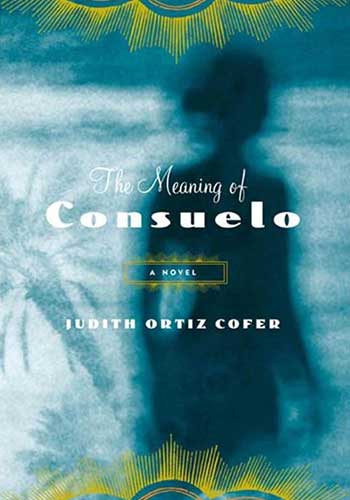
THE MEANING OF CONSUELO
Cofer, Judith Ortiz | Beacon, 2005 | Puerto Rico
The Signe family is blessed with two daughters. Consuelo, the elder, is thought of as pensive and book-loving, the serious child-la niña seria-while Mili, her younger sister, is seen as vivacious, a ray of tropical sunshine. Two daughters: one dark, one light; one to offer comfort and consolation, the other to charm and delight. But, for all the joy both girls should bring, something is not right in this Puerto Rican family; a tragedia is developing, like a tumor, at its core. In this fierce, funny, and sometimes startling novel, we follow a young woman's quest to negotiate her own terms of survival within the confines of her culture and her family.
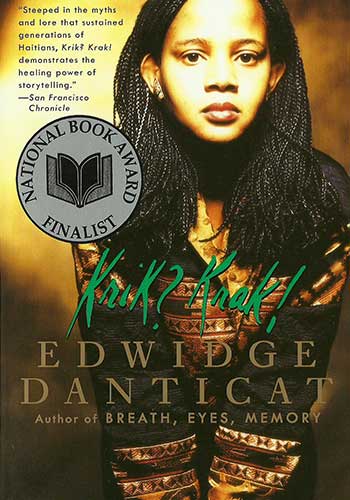
KRIK? KRAK!
Danticat, Edwidge | Vintage, 1996 |
Examining the lives of ordinary Haitians, particularly those struggling to survive under the brutal Duvalier regime, Danticat illuminates the distance between people's desires and the stifling reality of their lives. A profound mix of Catholicism and voodoo spirituality informs the tales, bestowing a mythic importance on people described in the opening story, "Children of the Sea," as those "in this world whose names don't matter to anyone but themselves." The ceaseless grip of dictatorship often leads men to emotionally abandon their families, like the husband in "A Wall of Fire Rising," who dreams of escaping in a neighbor's hot-air balloon. The women exhibit more resilience, largely because of their insistence on finding meaning and solidarity through storytelling; but Danticat portrays these bonds with an honesty that shows that sisterhood, too, has its power plays. In the book's final piece, "Epilogue: Women Like Us," she writes: "Are there women who both cook and write? Kitchen poets, they call them. They slip phrases into their stew and wrap meaning around their pork before frying it. They make narrative dumplings and stuff their daughter's mouths so they say nothing more."

ENCHANTED AIR: TWO CULTURES, TWO WINGS
Engle, Margarita | Atheneum, 2015 | Cuba | Available in Spanish
In this poetic memoir, which won the Pura Belpré Author Award, was a YALSA Nonfiction Finalist, and was named a Walter Dean Myers Award Honoree, acclaimed author Margarita Engle tells of growing up as a child of two cultures during the Cold War. Margarita is a girl from two worlds. Her heart lies in Cuba, her mother’s tropical island country, a place so lush with vibrant life that it seems like a fairy tale kingdom. But most of the time she lives in Los Angeles, lonely in the noisy city and dreaming of the summers when she can take a plane through the enchanted air to her beloved island. Words and images are her constant companions, friendly and comforting when the children at school are not. Then a revolution breaks out in Cuba. Margarita fears for her far-away family. When the hostility between Cuba and the United States erupts at the Bay of Pigs Invasion, Margarita’s worlds collide in the worst way possible. How can the two countries she loves hate each other so much? And will she ever get to visit her beautiful island again?

THE SURRENDER TREE
Engle, Margarita | Henry Holt and Co., 2010 | Cuba | Available in Spanish
It is 1896. Cuba has fought three wars for independence and still is not free. People have been rounded up in concentration camps with too little food and too much illness. Rosa is a nurse, but with a price on her head for helping the rebels, she dares not go to the camps. Instead, she turns hidden caves into hospitals for those who know how to find her. Black, white, Cuban, Spanish—Rosa does her best for everyone. Yet who can heal a country so torn apart by war?

EL ÁRBOL DE LA RENDICIÓN
Engle, Margarita | Henry Holt and Co., 2010 | Cuba | Available in English
Es el año 1896. Cuba ha enfrentado en tres guerras por la independencia y todavía no es libre. Las personas han sido detenidos en campos de concentración, con muy poca comida y demasiada enfermedad. Rosa es una enfermera, pero con un precio sobre su cabeza para ayudar a los rebeldes, no se atreve a ir a los campamentos. En cambio, ella se vuelve cuevas ocultas en los hospitales para los que saben cómo encontrarla. Negro, blanco, cubano, español-Rosa hace lo mejor para todos. Pero, ¿quién puede sanar un país tan desgarrado por la guerra?
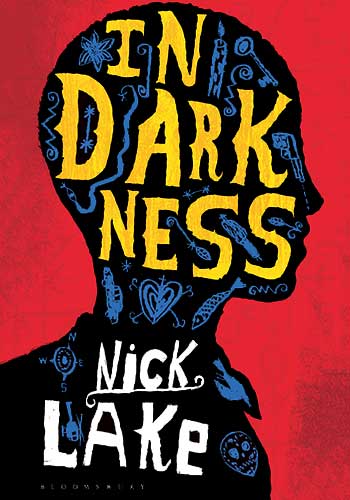
IN DARKNESS
Lake, Nick | Bloomsbury, 2012 | Haiti
Trapped beneath the rubble of the Haitian earthquake of 2010, a teenage boy is terrified, desperate and alone. A child of the slums, Shorty has been drawn into the world of the gangsters who rule his broken city, a world that turns dreams into dust and boys into killers.

UNDER THE MESQUITE
McCall, Guadalupe Garcia | Lee & Low, 2011 | United States
Lupita, a budding actor and poet in a close-knit Mexican American immigrant family, comes of age as she struggles with adult responsibilities during her mother’s battle with cancer in this young adult novel in verse. When Lupita learns Mami has cancer, she is terrified by the possibility of losing her mother, the anchor of her close-knit family. Suddenly, being a high school student, starring in a play, and dealing with friends who don’t always understand, become less important than doing whatever she can to save Mami’s life. While her father cares for Mami at an out-of-town clinic, Lupita takes charge of her seven younger siblings. As Lupita struggles to keep the family afloat, she takes refuge in the shade of a mesquite tree, where she escapes the chaos at home to write. Forced to face her limitations in the midst of overwhelming changes and losses, Lupita rediscovers her voice and finds healing in the power of words. Told with honest emotion in evocative free verse, Lupita’s journey toward hope is captured in moments that are alternately warm and poignant. Under the Mesquite is an empowering story about testing family bonds and the strength of a young woman navigating pain and hardship with surprising resilience.

YAQUI DELGADO WANTS TO KICK YOUR ASS
Medina, Meg | Candlewick, 2013 | United States
One morning before school, some girl tells Piddy Sanchez that Yaqui Delgado hates her and wants to kick her ass. Piddy doesn’t even know who Yaqui is, never mind what she’s done to piss her off. Word is that Yaqui thinks Piddy is stuck-up, shakes her stuff when she walks, and isn’t Latin enough with her white skin, good grades, and no accent. And Yaqui isn’t kidding around, so Piddy better watch her back. At first Piddy is more concerned with trying to find out more about the father she’s never met and how to balance honors courses with her weekend job at the neighborhood hair salon. But as the harassment escalates, avoiding Yaqui and her gang starts to take over Piddy’s life. Is there any way for Piddy to survive without closing herself off or running away? In an all-too-realistic novel, Meg Medina portrays a sympathetic heroine who is forced to decide who she really is.
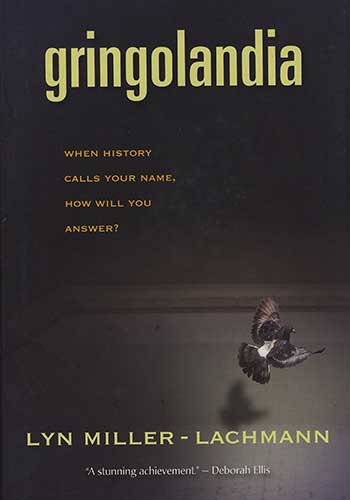
GRINGOLANDIA
Miller-Lachman, Lyn | Curbstone, 2009 | Chile
Daniel’s papá, Marcelo, used to play soccer, dance the cueca, and drive his kids to school in a beat-up green taxi—all while publishing an underground newspaper that exposed Chile’s military regime. After papá’s arrest in 1980, Daniel’s family fled to the United States. Now Daniel has a new life, playing guitar in a rock band and dating Courtney, a minister’s daughter. He hopes to become a US citizen as soon as he turns eighteen. When Daniel’s father is released and rejoins his family, they see what five years of prison and torture have done to him. Marcelo is partially paralyzed, haunted by nightmares, and bitter about being exiled to “Gringolandia.” Daniel worries that Courtney’s scheme to start a bilingual human rights newspaper will rake up papá’s past and drive him further into alcohol abuse and self-destruction. Daniel dreams of a real father-son relationship, but he may have to give up everything simply to save his papá’s life. This powerful coming-of-age story portrays an immigrant teen’s struggle to reach his tortured father and find his place in the world.

SHADOWSHAPER
Older, Daniel José | Levine, 2015 | Caribbean/United States
Paint a mural. Start a battle. Change the world. Sierra Santiago planned an easy summer of making art and hanging out with her friends. But then a corpse crashes the first party of the season. Her stroke-ridden grandfather starts apologizing over and over. And when the murals in her neighborhood begin to weep real tears… Well, something more sinister than the usual Brooklyn ruckus is going on. With the help of a fellow artist named Robbie, Sierra discovers shadowshaping, a thrilling magic that infuses ancestral spirits into paintings, music, and stories. But someone is killing the shadowshapers one by one — and the killer believes Sierra is hiding their greatest secret. Now she must unravel her family’s past, take down the killer in the present, and save the future of shadowshaping for generations to come. Full of a joyful, defiant spirit and writing as luscious as a Brooklyn summer night, Shadowshaper introduces a heroine and magic unlike anything else in fantasy fiction, and marks the YA debut of a bold new voice.
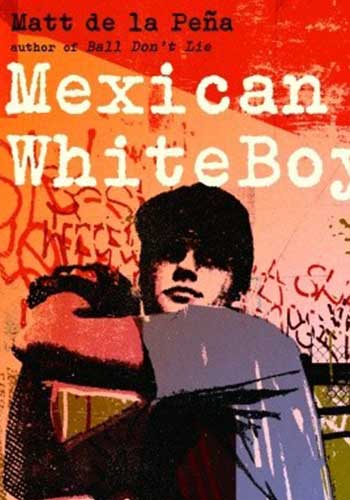
MEXICAN WHITEBOY
de la Peña, Matt | Ember, 2010 | United States/
Danny's tall and skinny. Even though he’s not built, his arms are long enough to give his pitch a power so fierce any college scout would sign him on the spot. Ninety-five mile an hour fastball, but the boy’s not even on a team. Every time he gets up on the mound he loses it. But at his private school, they don’t expect much else from him. Danny’ s brown. Half-Mexican brown. And growing up in San Diego that close to the border means everyone else knows exactly who he is before he even opens his mouth. Before they find out he can’t speak Spanish, and before they realize his mom has blond hair and blue eyes, they’ve got him pegged. But it works the other way too. And Danny’s convinced it’s his whiteness that sent his father back to Mexico. That’s why he’s spending the summer with his dad’s family. Only, to find himself, he may just have to face the demons he refuses to see--the demons that are right in front of his face. And open up to a friendship he never saw coming.
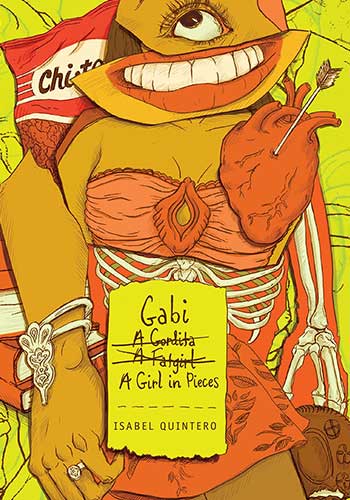
GABI, A GIRL IN PIECES
Quintero, Isabel | Cinco Puntos Press, 2014 | United States/
Gabi Hernandez chronicles her last year in high school in her diary: college applications, Cindy's pregnancy, Sebastian's coming out, the cute boys, her father's meth habit, and the food she craves. And best of all, the poetry that helps forge her identity. July 24. My mother named me Gabriella, after my grandmother who, coincidentally, didn't want to meet me when I was born because my mother was unmarried, and therefore living in sin. My mom has told me the story many, many, MANY, times of how, when she confessed to my grandmother that she was pregnant with me, her mother beat her. BEAT HER! She was twenty-five. That story is the basis of my sexual education and has reiterated why it's important to wait until you're married to give it up. So now, every time I go out with a guy, my mom says, "Ojos abiertos, piernas cerradas." Eyes open, legs closed. That's as far as the birds and the bees talk has gone. And I don't mind it. I don't necessarily agree with that whole wait until you're married crap, though. I mean, this is America and the 21st century; not Mexico one hundred years ago. But, of course, I can't tell my mom that because she will think I'm bad. Or worse: trying to be White.

ARISTOTLE AND DANTE DISCOVER THE SECRETS OF THE UNIVERSE
Sáenz, Benjamin Alire | Simon & Schuster, 2012 | United States/
Aristotle is an angry teen with a brother in prison. Dante is a know-it-all who has an unusual way of looking at the world. When the two meet at the swimming pool, they seem to have nothing in common. But as the loners start spending time together, they discover that they share a special friendship—the kind that changes lives and lasts a lifetime. And it is through this friendship that Ari and Dante will learn the most important truths about themselves and the kind of people they want to be.

HE FORGOT TO SAY GOODBYE
Sáenz, Benjamin Alire | Simon & Schuster, 2010 | United States/
Ramiro Lopez and Jake Upthegrove don’t appear to have much in common. Ram lives in the Mexican-American working-class barrio of El Paso called “Dizzy Land.” His brother is sinking into a world of drugs, wreaking havoc in their household. Jake is a rich West Side white boy who has developed a problem managing his anger. An only child, he is a misfit in his mother’s shallow and materialistic world. But Ram and Jake do have one thing in common: They are lost boys who have never met their fathers. This sad fact has left both of them undeniably scarred and obsessed with the men who abandoned them. As Jake and Ram overcome their suspicions of each other, they begin to move away from their loner existences and realize that they are capable of reaching out beyond their wounds and the neighborhoods that they grew up in. Their friendship becomes a healing in a world of hurt.
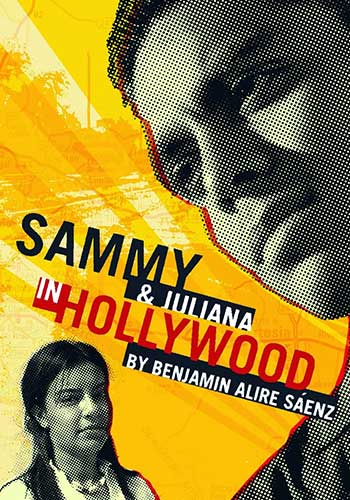
SAMMY AND JULIANA IN HOLLYWOOD
Sáenz, Benjamin Alire | Cinco Puntos Press, 2004 | United States/
The “Hollywood” where Sammy Santos and Juliana Ríos live is not the West Coast one, the one with all the glitz and glitter. This Hollywood is a tough barrio at the edge of a small town in southern New Mexico. Sammy and this friends—members of the 1969 high school graduating class—face a world of racism, dress codes, war in Vietnam and barrio violence. In the summer before his senior year begins, Sammy falls in love with Juliana, a girl whose tough veneer disguises a world of hurt. By summer’s end, Juliana is dead. Sammy grieves, and in his grief, the memory of Juliana becomes his guide through this difficult year. Sammy is a smart kid, but he’s angry. He’s angry about Juliana’s death, he’s angry about the poverty his father and his sister must endure, he’s angry at his high school and its thinly disguised gringo racism, and he’s angry he might not be able to go to college. Benjamin Alire Sáenz, evoking the bittersweet ambience found in such novels as McMurtry’s The Last Picture Show, captures the essence of what it meant to grow up Chicano in small-town America in the late 1960s.
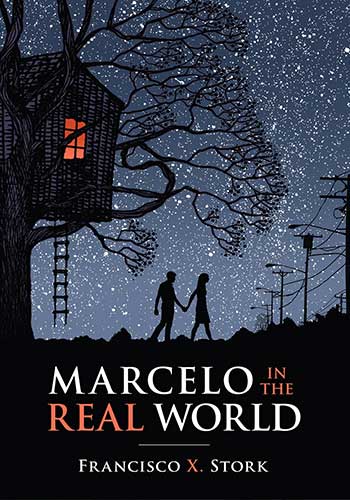
MARCELO IN THE REAL WORLD
Stork, Francisco X. | Scholastic, 2011 | United States/
The term "cognitive disorder" implies there is something wrong with the way I think or the way I perceive reality. I perceive reality just fine. Sometimes I perceive more of reality than others. Marcelo Sandoval hears music that nobody else can hear ― part of an autism-like condition that no doctor has been able to identify. But his father has never fully believed in the music or Marcelo's differences, and he challenges Marcelo to work in the mailroom of his law firm for the summer . . . to join "the real world." There Marcelo meets Jasmine, his beautiful and surprising coworker, and Wendell, the son of another partner in the firm. He learns about competition and jealousy, anger and desire. But it's a picture he finds in a file a picture of a girl with half a face that truly connects him with the real world: its suffering, its injustice, and what he can do to fight.
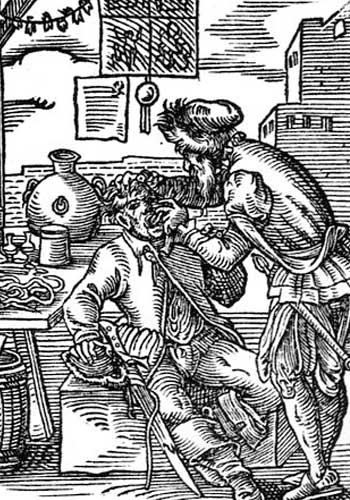
"One of These Days" / Un día de estos"
García Márquez, Gabriel | Vintage Español, 1962 | Colombia | Available in English/Spanish
A humble dentist, Aurelio Escovar, lives in a town riddled with corruption. When the murderous mayor arrives in his office, the dentist refuses to treat him. The mayor pulls a gun on the dentist and demands treatment for what Escovar discovers to be an infected wisdom tooth. He agrees to treat him, but without the aid of anesthesia saying, "Now you'll pay for twenty dead men.”
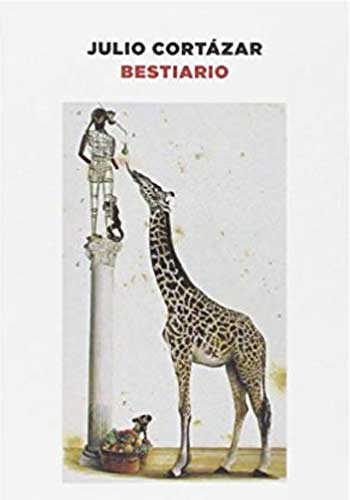
"House Taken Over" / "Casa tomada"
Cortázar, Julio | Alfaguara, 1952 | Argentina | Available in English / Spanish
The narrator and his sister, Irene, have inherited a large mansion, in which they live happily with generations of keepsakes. Irene has taken up knitting and the narrator loves literature. They stick to an easy routine, until one day an entity takes over a part of their house, until eventually they must abandon it.
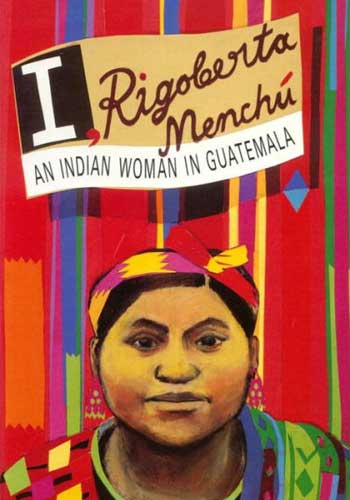
"First Visit to the Finca" / "Primer viaje a la finca"
Menchú, Rigoberta | Verso, 2010 | Guatemala | Available in English / Spanish
Now a global bestseller, the remarkable life of Rigoberta Menchú, a Guatemalan peasant woman, reflects on the experiences common to many Indian communities in Latin America. Menchú suffered gross injustice and hardship in her early life: her brother, father and mother were murdered by the Guatemalan military. She learned Spanish and turned to catechistic work as an expression of political revolt as well as religious commitment. Menchú vividly conveys the traditional beliefs of her community and her personal response to feminist and socialist ideas. Above all, these pages are illuminated by the enduring courage and passionate sense of justice of an extraordinary woman.

